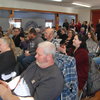Logan explores the symbiotic relationship between people and trees
RENSSELAERVILLE — How do you help a tree to grow? To be healthier? To live longer?
The answer lies in human history as it’s captured by Rensselaerville author and arborist William Logan in his 2019 book, “Sprout Lands: Tending the Endless Gift of Trees,” which has just been awarded the John Burroughs Medal.
Named after the naturalist writer, the John Burroughs Medal is awarded to premier authors of natural history, including Rachel Carson, whose work helped promulgate the dangers of certain pesticides and spurred the creation of the Environmental Protection Agency.
“For the kind of writing I do, this is the big award in the United States,” Logan told The Enterprise as he described the heady experience of receiving a phone call from John Burroughs’s great-granddaughter, Joan Burroughs, who informed him of the selection.
Logan’s book, researched and written over a five-year period, explores the history of two ancient and intercultural tree-pruning techniques known as coppicing and pollarding, which can be described simply as two ways of cutting a tree and allowing it to regrow. A coppiced tree is cut to ground level while a pollarded tree is cut higher up. Both methods, done correctly, make for a happier tree, Logan was surprised to learn.
As the founder and president of the New York City-based company Urban Arborists, Logan initially wanted to find out more about coppicing and pollarding because the company had been hired to apply the techniques to trees in front of the Metropolitan Museum of Art, and he had only a little bit of experience with the techniques, mostly in his capacity as a teacher of arborist practices.
Describing the techniques as “very resourceful” for cultures that would use trees for charcoal, animal feed, lumber, and the like, Logan figured at the outset of his research, which brought him all over the world, including Norway, Spain, Japan and the western United States, that there would a tradeoff in trees’ lifespans.
“I was shocked to find that this was not true,” Logan said. “And not only was it not true in a few places, it was not true almost wherever this was practiced in the world. And that, in fact, the trees that had been treated this way and were repeatedly cut lived a longer time than the trees that had not been cut. And the forests they created by doing these things were more diverse, longer lived, and healthier than the uncut forests.”
Logan said he had been trained as an arborist to “leave the trees alone, let them grow the way they want to grow.”
“A lot of what is called pollarding and coppicing is not, and is actually very damaging to trees,” Logan qualified, “but when done correctly, the plants can live a very long time.”
A natural balance
Wrapped up in this world-bending discovery was a spirit of collaboration between people and the environment that had saturated pre-industrial cultures.
And it was the industrial revolution that stomped down these techniques in favor of rapid production, Logan said, and obscured people’s bond with nature in many places around the world.
“We talk about the environment as though, somehow, the environment is separate from us,” Logan said, “but it isn’t.”
He contrasted the separatist view of nature with that of the Japanese, who have long treated nature as intrinsic, as reflected in classic Japanese poetry and the more modern practice of “forest bathing.”
And, of the people he met around the world who practiced coppicing and pollarding, Logan said that none of them would have fallen into that trap of viewing nature as separate because they knew very well that “the way that they worked and responded to the world around them made a difference not only to their families living there, but also to all the other creatures that lived there.
“And they knew that to be true,” Logan continued, “because they did it, and their ancestors did it, and as far as they knew everyone was going to continue to do it. So it was interesting for me how much continuity there was between looking at a charcoal maker in Japan and a shepherd in northern Spain who would pollard his ash trees … There was great commonality between their view of nature because it was something in which they found the relationship to be the important thing.”
In his travels, Logan also visited a farm in Norway, called Grinda Farm, which he said has been operating since the Bronze Age, and has practiced pollarding through its history up to the present day. Logan said that, when speaking with the operator of the farm, Lars Grinda, he remarked that the Grinda family had clearly been in the area for a long time, to which Grinda replied that his grandfather was the first of his family to settle there.
“I said, ‘But your name is Grinda, and the farm has been named Grinda, as far as I know, since the Bronze Age,’” Logan recounted. “And he said, ‘Yes, yes, yes, but you must understand that on a traditional farm in Norway, when you come and farm it, you take the last name of the farm.’”
That kind of reverence for nature can seem shocking, especially in the United States, where although the U.S. Board on Geographic Names has rejected the use of possessive names in all but a handful of cases, people often can’t help but look at property through the lens of ownership, of man over nature.
Instead, the symbiotic attitude is found in niche domains, like alternative education, as was the case with the students of a New York City Steiner school — a type of school that runs on the educational philosophy of esotericist Rudolf Steiner — whom Logan came upon in Central Park one day as they were building what looked like fairy huts using twigs and tree detritus.
“I thought they were on recess, but their teacher came over to make sure I wasn't being mean to their charges,” Logan said. “And I asked, ‘Is this recess?’ And she said, ‘No, it's our forest period.’
“Children in the Steiner school … have a forest period. One of their classes is to go out and just do what they do in the forest. And very often it's something like building a little house or collecting something or simply walking around, and people really value that.”
Reduce, reuse, regrow
The broad biological explanation for the benefits pollarding and coppicing provides trees is that trees, unlike humans, Logan said, have very few, but very efficient organs, and so they’re specialized for regrowth.
“We have all these organs, and none of them work very well,” Logan explained. “Trees only have three, and they repeat them again and again their whole lives long.” Trees have roots, stems or trunks, and crowns or leaves.
“And that being the case, they’re very able to respond to the loss of a stem, because it’s no big deal to them,” said Logan. “They’ll put back five or six of them.”
Also, Logan said, the removal of one component means that elements like decay or parasites that exist with it will no longer affect the whole tree, as the new growth will of course be free of such things, at least for a time.
“Trees have kind of a different way of living than we do,” Logan said. “They aren’t dependent upon having a body that grows up to an adult form and maintains that form until the creature dies. They’re very good at repeating, making new, repeated structures all over themselves, from top to bottom, in order to stay alive.
“As a result, some can stay alive for a very, very long time, as we see in redwood forests,” Logan said. He added that while writing the book, he learned of a shrub in Tasmania, called the Lomatia tasmanica, that’s “at least 46,000 years old.”
“Because trees are able to repeat in this way,” Logan said, “in theory, they can live forever.”
And not only do they live longer, but paring back the unhealthy parts of a tree makes for thicker growth, Logan said, which is good for pollinators and promotes biodiversity.
Although Logan doesn’t view the practice as one that could be applied universally, he said it would have great utility in urban areas, where tree limbs can fall and harm people, and roots can disturb infrastructure; coppicing and pollarding would retract both features.
But ultimately, he said, the point of his book is not to promote a practical means, “but to take that [collaborative] attitude toward nature and toward woodlands again, an active attitude where we’re interested in their health and their longevity as much as what we get out of them.”



